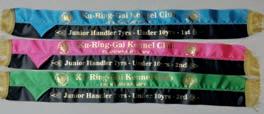
3 minute read
First Aid – Anaphylactic Shock
Anaphylactic, SHOCK
Joanne Bibby – Fursafe® Anaphylactic Shock is when a dog reacts negatively to a substance, for example, chemicals or medications, a substance which is either inhaled, absorbed or ingested, and that which triggers an allergic reaction or severe inflammation.
Depending on the substance, a dog may experience only a mild reaction, such as itching, however there are dogs, just as with some humans, who are susceptible to a more severe response. Symptoms may compromise lung function and impact other organs such as the liver, thereby threatening their lives. Anaphylactic shock is an emergency and is to be treated by a Vet urgently. We as dog owners do not treat this condition, rather we arm ourselves with the knowledge of the signs and symptoms so we can identify it quickly and get to the Vet without delay. It may be necessary to treat various symptoms if or when they arise, for example, if the dog stops breathing, we would administer CPR without delay. CAUSES OF ANAPHYLACTIC SHOCK The following substances may cause an allergic reaction within your dog: • Insect sting or bite (e.g., bees, wasps, ants); • Drugs/medications; • Human foods;
• Chemicals;
• Dust;
• Flora such as plants, nettles and seeded grasses; and/or
• Your dog may have a flea allergy. SAFETY PRECAUTIONS If your dog is susceptible to anaphylaxis then the best strategy is to avoid exposing your dog to triggers, such as: • Keep medications locked away and/or out of reach;
• Be careful when you take medication that you don’t drop it on the floor – lean over a counter or bench or pick it up the moment it falls;
• Keep chemicals out of reach;
• Vacuum, dust and wash bedding regularly; • Identify the plants in and around your home and remove if they are toxic;
• Check out where your dog is walking or what they are standing on to reduce the risk of being stung or bitten;
• Talk to your Vet about other potential allergies; • Vaccinate as scheduled by your Vet.
SIGNS AND SYMPTOMS Your dog may show some or all of the following: • Excessive itching – hives come up out of nowhere (raised welts on skin), red, inflamed skin.
• Face, ears, eyes, mouth swelling.
• Vomiting. • Abnormal drooling. • Weakness when moving. • Uncontrolled bowel movements.
• Dog appears exhausted. • Heart rate is racing (tachycardia) but pulse is weak. • Legs feel cold.
• Seizures.
• Can’t be roused, unconsciousness.
• Monitor heart rate as cardiac arrest may occur if left untreated.
ACTION 1. Undertake Primary Assessment
a. Check the airway for blockages or foreign objects; remove if there is. If your dog has been vomiting finger swipe or use a tongue depressor to scoop out the vomit. Keep airway open, extend neck, pull tongue forward. b. Check the breathing (respirations) e.g., count the rise and fall of the chest – start artificial respiration if not breathing. Is the breathing normal or shallow, fast or not breathing?
Monitor all the way to the Vet! c. Check circulation (pulse) – does your dog have a pulse? Start CPR if no pulse.
2. Locate and remove allergen. Wash away pollens or fluids. For a sting, scrape sideways – pulling out may leave some of the sting in the body. 3. If the allergen is a food, plant, chemical or medication, take a sample with you to Vet.
4. Wrap dog in blanket securely and place in crate or box.
5. Monitor/manage for seizures. 6. Speak soothingly and stroke to keep calm and quiet.

7. Transport to Vet.
8. Monitor breathing during transport to Vet. If you can get someone to drive you: • Sit in the back with your dog. • Monitor during transport to Vet to make sure your dog is breathing. • If your dog stops breathing, begin artificial respiration.
• If your dog’s heart stops beating, begin CPR. Reference: Fursafe® Emergency Dog First Aid Guide

Est 1977
“ HOT FOIL STAMPING SPECIALIST ” PHONE: ( 02 ) 47741809
EMAIL: marellen@marellenshowribbons.com ADDRESS: 109 Silverdale Rd Silverdale N.S.W. 2752
WEB: www.marellenshowribbons.com
“ FIND US ON FACEBOOK FOR FAST COMMUNICATION ”












